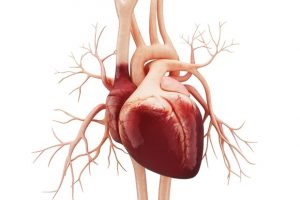Machine learning model detects heart attacks faster and more accurately than current methods

A new machine learning model uses electrocardiogram (ECG) readings to diagnose and classify heart attacks faster and more accurately than current approaches, according to a study led by University of Pittsburgh researchers that published today in Nature Medicine.
"When a patient comes into the hospital with chest pain, the first question we ask is whether the patient is having a heart attack or not. It seems like that should be straightforward, but when it's not clear from the ECG, it can take up to 24 hours to complete additional tests," said lead author Salah Al-Zaiti, Ph.D., R.N., associate professor in the Pitt School of Nursing and of emergency medicine and cardiology in the School of Medicine. "Our model helps address this major challenge by improving risk assessment so that patients can get appropriate care without delay."
Among the peaks and valleys of an electrocardiogram, clinicians can easily recognize a distinct pattern that indicates the worst type of heart attack called STEMI. These severe episodes are caused by total blockage of a coronary artery and require immediate intervention to restore blood flow.
The problem is that almost two-thirds of heart attacks are caused by severe blockage, but do not have the telltale ECG pattern. The new tool helps detect subtle clues in the ECG that are difficult for clinicians to spot and improves classification of patients with chest pain.
The model was developed by co-author Ervin Sejdić, Ph.D., associate professor at The Edward S. Rogers Department of Electrical and Computer Engineering at the University of Toronto and the Research Chair in Artificial Intelligence for Health Outcomes at North York General Hospital in Toronto, with ECGs from 4,026 patients with chest pain at three hospitals in Pittsburgh. The model was then externally validated with 3,287 patients from a different hospital system.
The researchers compared their model to three gold standards for assessing cardiac events: experienced clinician interpretation of ECG, commercial ECG algorithms and the HEART score, which considers history at presentation -; including pain and other symptoms -; ECG interpretation, age, risk factors-;such as smoking, diabetes, high cholesterol -; and blood levels of a protein called troponin.
The model outperformed all three, accurately reclassifying 1 in 3 patients with chest pain as low, intermediate or high risk.
In our wildest dreams, we hoped to match the accuracy of HEART, but we were surprised to find that our machine learning model based solely on ECG exceeded this score."
Salah Al-Zaiti, Lead Author
According to co-author Christian Martin-Gill, M.D., M.P.H., chief of the Emergency Medical Services (EMS) division at UPMC, the algorithm will help EMS personnel and emergency department providers identify people having a heart attack and those with reduced blood flow to the heart in a much more robust way compared with traditional ECG analysis.
"This information can help guide EMS medical decisions such as initiating certain treatments in the field or alerting hospitals that a high-risk patient is incoming," Martin-Gill added. "On the flip side, it's also exciting that it can help identify low-risk patients who don't need to go to a hospital with a specialized cardiac facility, which could improve prehospital triage."
In the next phase of this research, the team is optimizing how the model will be deployed in partnership with City of Pittsburgh Bureau of Emergency Medical Services. Al-Zaiti said that they're developing a cloud-based system that integrates with hospital command centers that receive ECG readings from EMS. The model will analyze the ECG and send back a risk assessment of the patient, guiding medical decisions in real-time.
Other authors who contributed to this research were Zeineb Bouzid, Stephanie Helman, M.S.N., R.N., Nathan Riek, Karina Kraevsky-Phillips, M.A., R.N., Gilles Clermont, M.D., Murat Akcakaya, Ph.D., Susan Sereika, Ph.D., Samir Saba, M.D., and Clifton Callaway, M.D., Ph.D., all of Pitt; Jessica Zègre-Hemsey, Ph.D., R.N., of the University of North Carolina; Ziad Faramand, M.D., of Northeast Georgia Health System; Mohammad Alrawashdeh, Ph.D., of Harvard Medical School; Richard Gregg, M.S., of Philips Healthcare; Peter Van Dam, of University Medical Center Utrecht; Stephen Smith, M.D., of Hennepin Healthcare and the University of Minnesota; and Yochai Birnbaum, M.D., of Baylor College of Medicine.
This research was supported by the National Heart, Lung, and Blood Institute, the National Center for Advancing Translational Sciences and the National Institute for Nursing Research through grants R01HL137761, UL1TR001857, K23NR017896 and KL2TR002490.
University of Pittsburgh
Al-Zaiti, S. S., et al. (2023). Machine learning for ECG diagnosis and risk stratification of occlusion myocardial infarction. Nature Medicine. doi.org/10.1038/s41591-023-02396-3.
Posted in: Device / Technology News | Medical Condition News
Tags: Artificial Intelligence, Blood, Cardiology, Chest Pain, Cholesterol, Diabetes, Emergency Medicine, Healthcare, Heart, Heart Attack, High Cholesterol, Hospital, Machine Learning, Medical School, Medicine, Nursing, Pain, pH, Protein, Research, Smoking, Triage, Troponin
Source: Read Full Article